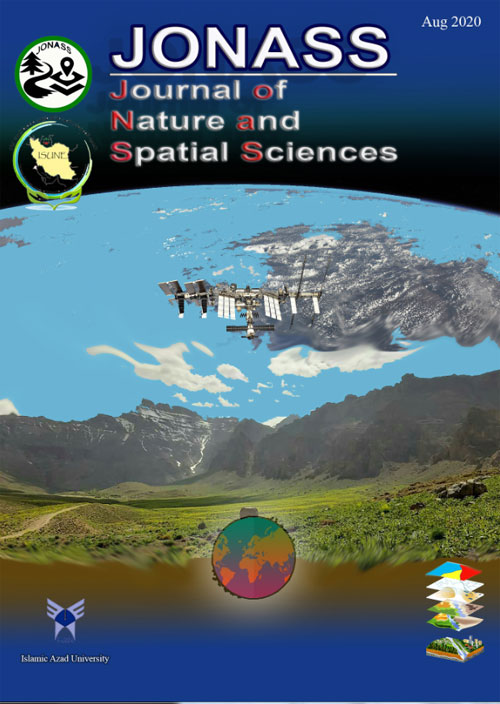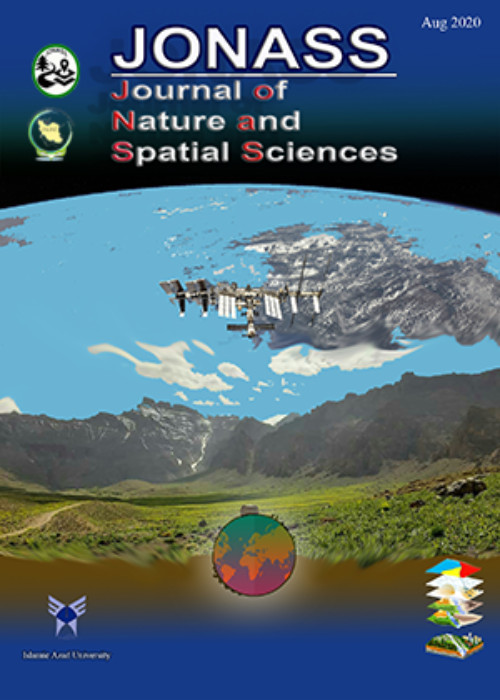فهرست مطالب

Journal of Nature and Spatial Sciences
Volume:1 Issue: 1, Winter and Spring 2021
- تاریخ انتشار: 1399/11/13
- تعداد عناوین: 6
-
Pages 1-16Background and objectives
Debris flow waste-shoal land (DFWSL) is a unique land resource with significant use prospects and development value (e.g. agriculture, urbanization, and infrastructure land). However, a lack of understanding of environment capacity hinders the development and use of such land.
Materials and methodsTherefore, this study examines DFWSL and relevant human and natural factors and proposes the concept of the social-ecological environment capacity (SEEC) of DFWSL. We explain the connotation by exploring the evaluation index system based on various theories, such as the dissipation structure theory, ecological disaster and change theory, ecosystem balance theory, ecosystem functional value assessment theory, land cover/land change, and related knowledge.
Results and conclusion:
Moreover, we form the framework for and research approaches to the SEEC of DFWSL. In this method, the number of active agents and the activity intensity are considered to evaluate the SEEC of the DFWSL system, and the distribution characteristics of active agents with dynamic states in different spatial and temporal scales are used to characterize the heterogeneity within the DFWSL system. We attempt to provide theoretical guidance for improving land use efficiency in mountainous areas relevant to maintaining ecological security and sustainable economic development.
Keywords: Debris flow waste-shoal land, Social-ecological environment capacity, land use, Social-ecological systems, Mountainous area -
Pages 17-26Background and objective
Dust is one of the most important destructive climatic phenomena that cause great damage to human health and the environment every year. In Iran, due to having a 23% share of dust storms in the world and the transfer of dust from Iraq and Saudi Arabia, it is necessary to study it. Dust storms in Iran during the last few years have been a serious crisis in the western and south-western provinces of the country, including Khuzestan province, and have had dangerous consequences in the fields of environment, health, and economy.
Materials and methodsThis study examines the changes in the dust during the last 40 years (1980-2020) in the western and south-western regions of Iran and Iran's neighbors (Kuwait, east and southeast of Iraq, and northern Saudi Arabia). And its relationship to wind stress and vegetation has been investigated using MERRA-2 satellite imagery and model maps from the Giovanni site. Dust monitoring from June 2018 to February 2021 has also been analyzed through Google Earth Engine, a specialized web-based remote sensing system.
Results and conclusion:
The results show that during the 40 years under study, especially from 2020 to 2010, the volume of dust and wind stress in the study area has increased significantly. Also, dust, vegetation, wind stress have had related changes over 40 years, so that wind stress is directly related to the amount of dust and increases its effects. Also, in areas with more vegetation, there is less dust.
Keywords: dust, wind, Vegetation, Giovanni NASA -
Pages 27-41Background and objective
The changes in desert areas depend on climate conditions and the water balance of upstream watersheds. Satellite images can help us in distinguishing the trend of areas of Playa Wetland and with achieving these trends, both the status of the non-conventional water resources will be identified and this information can be used in wind erosion management.
Materials and methodsIn the present study, the changes in Gavkhuni Wetland was evaluated using MODIS satellite images from 2000 to 2016. For this purpose, after performing the required modifications on the satellite images, they were classified and their changes in studies time intervals were detected. Since the changes of desert areas depend on the humidity variations, the TVDI، MTVDI، VTCI indices were calculated to enhance the satellite images. The indices along with the bands of MODIS images were used in classification. The classification was done in August and March (maximum changes in desert areas and wet age) during 16 years. Due to the large number of used images, coding in MATLAB software was used to facilitate calculation of these parameters.
Results and conclusion:
The results indicated that in August and March, the desert areas faced descending precipitation, which led to reducing water rights. In the studied intervals, in 78.98% of the study areas, no changes were observed and the maximum changes (15%) were for a wet edge. Evaluating the validity of the maps revealed that the Kappa coefficient and total validation were respectively 95% and 96%.
Keywords: satellite imagery, MODIS, Gavkhuni Wetland, Desert surface -
Pages 42-48Background and objective
Persian gazelle is considered one of the indicators and vulnerable species in Iran. Although, several studies have been so far conducted on this species in different areas of Iran, there is no complete ecological information about the species habitat selection. This study tried to examine the habitat selection of the Persian gazelle based upon quantify habitat variables (pellet groups) in the areas of animal's presence
Materials and methodsSampling was done in each habitat type using random steady transects with 200 meters' length and 2 meters width, and such habitat variables as percentage of vegetation cover, species richness, and distance from the nearest water source, farms, roads, and areas of human development were measured.
Results and conclusion:
The results indicated that the density of pellet groups was different between different plant communities. It was also shown, that habitat variables such as percent cover of plant species Artemisia siberi, species richness and distance to road are important factors that influence the habitat selection of this species in Kalmand protected area.
Keywords: Persian Gazelle, Habitat selection, Conservation, Iran -
Pages 49-58Background and objective
The alluvial fan of the Shahdad is one of the huge alluvial in perfectly dry regions in the north eastern Kerman. This alluvial fan is formed by the effect of different materials erosion into the drainage basin of Shahdad River and laying these materials in the final part of this drainage basin called Lut plain. Tectonic acts with efficacy in the place of the settlements of the fan and this place is one of the active tectonic regions. The aim of this article is the morphology of the Derakhtangan river fan indicative of neotectonics in the region.
Materials and methodsThe method of this research is descriptive-analytical. In the descriptive part, the changes in the region were studied using documentary studies and then using aerial photographs, Google Earth, geological maps and field studies.
Results and conclusion:
One of the most important pieces of evidence in the region is the various faults in the area and imply to fan alluvium (from head to end), study line profile in past and present. The most important fault of the region is the great fault of Naiband, the southern fault of Shahdad and the series of faults having the direction of northwestern to southeastern and northern and Southern. The drainage basin of the alluvial fan of Shahdad leads from east to Lut and from west to the mountains of Bagbala and Kalisakie from north to the altitudes of Deahran and from south to the mountains of Joftan.
Keywords: Active tectonic, Alluvial Fan, Effect of faults, Morphology, Shahdad -
Pages 59-84Background and objective
The SVM algorithm is an applied method that has been considered in recent years to study landslides. The main purpose of this study is to evaluate the mapping power of the GIS-based SVM model with kernel functions analysis for spatial prediction of landslides at the Ilam dam watershed.
Materials and methodsAccording to review sources, 14 underlying factors including elevation, slope, aspect, plan curvature, profile curvature, LS factor, TWI, SPI, Lithologic units, land cover, NDVI, road distance, distance to the drainage channel, distance to fault were selected as factors affecting the occurrence of landslides in the study area and the mentioned layers were prepared in the GIS. In the present study, the non-linear two-class SVM method was used, the two-class SVM requires both datasets representing the occurrence of landslides and non-occurrence of landslides. The landslide inventory was randomly divided into a training dataset of 75% for building the models and the remaining 25% for the validation of the models.
Results and conclusion:
The validation results showed that the area of the prediction-rate curve under the curve (AUC) for landslide susceptibility maps produced by the SVM linear function, SVM polynomial function, SVM radial basic function, and SVM sigmoid function are 0.946, 0.931, 0.912, and 0.871 respectively. To assess the influences of factors on the landslide susceptibility map were used the Cohen’s kappa index of the model. The result shows that the most effective factors are the distance to roads, distance to drainages, and plan curvature in this area.
Keywords: Landslide susceptibility mapping, Support vector machines (SVM), GIS, Ilam dam


